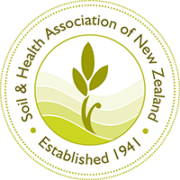What’s in that vaccine?
In the last issue of Organic NZ [March/April 2011], a reader wrote that she was ‘shocked to find out that the generic immunisation injection drug INFANRIX is based on a culture of genetically engineered yeast cells’.
The horror with which some may regard the idea of genetically modified vaccines may pale into insignificance once they gain an understanding of what else goes into vaccines. The worrying aspect of this is that few people have any idea what is being injected into their own or their child’s body.
How are vaccines made and what’s in them?
Vaccine manufacture essentially involves the growth of the virus or bacteria on a cell culture, then modification or inactivation so that the virus or bacteria is theoretically incapable of causing disease, followed by the addition of a number of chemicals to stabilise, strengthen and sterilise the vaccine.
Cells from other organisms are used, as a medium on which to grow the virus or bacteria; as part of a nutritive broth in which the growth medium is bathed, or for serial passage – passing the virus through the culture numerous times in order to reduce its potency. The cell cultures include monkey kidney, foetal calf serum, chick embryo fluid, yeast and human diploid cells (cells from aborted human foetuses).
In the case of the human cells, cells derived from the lung tissue of a three-month old female foetus are used in the manufacture of the rubella vaccine,1 and cells from the lung tissue of a 14-week-old male foetus2 are used in the manufacture of the chickenpox,3 hepatitis A4 and some killed virus polio vaccines. 5
Contamination by viruses and pathogens
While the use of animal and human cells to culture viruses and bacteria has moral implications for many people, the most serious problem with the use of these cell cultures is the potential contamination of the vaccine by remnants of the host tissue and viruses – known and unknown – that may be present in the host animal tissue and are transferred to the vaccine.
Contamination of vaccines by viruses and other pathogens from cell cultures is well documented; the most infamous episode is the contamination of polio vaccines with the SV40 virus in the 1950s and 60s. This simian (monkey) virus contaminated both the killed and live virus vaccines that were administered to millions of children. It has been confirmed beyond doubt that the virus has caused a variety of cancers in a large number of vaccine recipients.6,7 SV40 has also been found in the sperm and blood of healthy people,8 indicating that the virus can be transmitted from generation to generation along gene lines.
More recently the widespread use of foetal bovine serum raised the spectre of transmitting mad cow disease (bovine spongiform encephalopathy) as variant Creutzfeld-Jacob Disease (vCJD)9 in the UK. It was found that a pharmaceutical company was still using locally sourced foetal bovine serum for a polio vaccine in 2000, at the height of the mad cow disease outbreak, despite previous assurances that this practice had ceased in 1994.10 The vaccine had been given to seven million people. Closer to home, SmithKline Beecham discovered that its oral polio vaccine in Australia was made using foetal bovine serum sourced from Britain and that there was a risk of Australians developing vCJD as a result.11
Despite reassurances from the pharmaceutical industry and health agencies about the safety of vaccines made using animal cell cultures, the absence of evidence doesn’t mean evidence of absence. They can’t find something they are not looking for. It is all very well testing vaccines for known animal viruses, but who is testing for all the viruses we don’t yet know about?
Chick embryo cells are used for a number of vaccines including measles and mumps vaccines, and the yearly flu vaccine. Most readers will have heard of avian flu; culturing flu vaccines on substrates that may harbour as yet unknown avian flu viruses seems to be an exercise in futility, if not stupidity. Avian viruses have already been identified in the chick embryo cell culture used for measles and mumps vaccine,12,13 and in 2006 flu vaccine manufacturer Sanofi Pasteur found that 11 lots of its concentrate used to make the flu vaccine at its Pennsylvania factory were contaminated with an unnamed microbe; they were subsequently chastised by the US FDA.14
GE used to speed up mass manufacture
Contamination issues, together with the sheer scale of producing enough vaccine every time there is a official panic over a possible influenza pandemic (real or imagined), has led to suggestions that the flu vaccine should be manufactured using genetic engineering, making a recombinant vaccine. It was reported in early March 2011 that the US Department of Health and Human Services had awarded two contracts for the development of next-generation recombinant influenza vaccines that do not require egg-based technology. Using new vaccine technology and insect cells to express influenza proteins, one company says that they can manufacture commercial quantities of vaccine within 10 to 14 weeks, compared with four to six months with traditional egg-based methods.15
A cocktail of chemicals
While you won’t know whether or not you get a dose of unidentified – and not tested-for – pathogen of avian, bovine or some other animal origin, what you definitely will get in your vaccine is a cocktail of chemicals including:
- Agents that are used to inactivate the virus, bacteria or toxoid.
- Preservatives that are used to prevent bacterial growth in the vaccine solution.
- Stabilisers that are used to help maintain vaccine ‘effectiveness’ and stability during transport and storage
- Adjuvants that enhance the immune response to the vaccine.
Most vaccines, except for live virus vaccines, contain formaldehyde, an extremely toxic compound which is known to cause cancer in humans and animals.16,17,18 Some contain 2-phenoxyethanol, a preservative that irritates the skin, eyes, mucous membranes and respiratory tract19 and is a suspected developmental and reproductive toxicant.
Adverse health effects
The use of aluminium as an adjuvant is of particular concern because of its toxicity.20,21 Babies can receive up to 3.75 milligrams of aluminium from vaccines in the first six months of life. It is known that vaccines that contain aluminium frequently cause reactions at the injection site22 and can precipitate an allergic response to subsequent doses of the vaccine.
Among a number of serious health effects – including Macrophagic myofasciitis23 and aluminium allergy24 – aluminium containing vaccines can cause a transient rise in brain tissue aluminium25 and aluminium has been associated with Alzheimer’s disease and dementia.26,27 One study showed that aluminium may affect the permeability of the blood-brain barrier and allow neurotoxins such as aluminium to reach the central nervous system.28 It is a suspected cardiovascular and blood toxicant, neurotoxicant and respiratory toxicant.29
A variety of other compounds can be found in vaccines, including lactose, sorbitol, sodium chloride, sucrose, sodium borate, magnesium chloride, sodium phosphate, hydrolised gelatin, human albumin and the antibiotics neomycin, gentimicin and streptomycin.
Make an informed decision
Before you make a decision to have any vaccine administered to yourself or a child, ensure you know what is in the vaccine. Don’t just rely on the information provided to patients. Check out the vaccine data sheet online atwww.medsafe.govt.nz/profs/Datasheet/datasheet.htm and insist on reading the package insert before you have the jab.
And you should obtain the following information prior to vaccination for your records, verified and signed by the vaccine administrator: evidence that you (or your child) are healthy; evidence that a child is developing normally; time and date of administration; name of vaccine administrator and credentials; name and manufacturer of vaccine; the lot and batch number; and written verification that the vaccine has been stored correctly at all times.
Having been very careful about everything she did during pregnancy, to ensure her baby was as healthy as possible, Sue Claridge was not about to vaccinate her first child without knowing exactly what was being injected into her body and why. Armed with skills gained during her MSc research, she began investigating vaccinations, and eleven years later is still researching and writing about vaccine issues.
References
1. Merck Sharp and Dohme, 2002: M-M-R II Data Sheet, on www.medsafe.govt.nz/Profs/datasheet/m/mmriiinj.htm(accessed July 2002).
2. ViroMed Laboratories Inc: Selected Profiles of Cell Cultures, http://vml.viromed.com/services/product/profs.htm(accessed July, 2002).
3. SmithKline Beecham, 2000: Varilrix Data Sheet, on www.medsafe.govt.nz/Profs/datasheet/v/Varilirixinj.htm(accessed July, 2002).
4. GlaxoSmithKline, 2001: Twinrix and Twinrix Junior Data Sheet, onwww.medsafe.govt.nz/Profs/datasheet/t/Twinrixinj.htm (accessed July 2002).
5. CSL, 2000: Inactivated Poliomyelitis Vaccine (Diploid Cell Origin), onwww.medsafe.govt.nz/Profs/datasheet/i/Inactivepolioinj.htm (accessed July 2002).
6. Fisher, S.G., et al., 1999: Cancer risk associated with simian virus 40 contaminated polio vaccine, Anticancer Res, 19 (3B): 2173-80.
7. Carbone, M., Rizzo, P., Pass, H., 2000: Simian virus 40: the link with human malignant mesothelioma is well established, Anticancer Res, 20 (2A): 875-7.
8. Martini, F., et al.,1996: SV40 early region and large T antigen in human brain tumors, peripheral blood cells, and sperm fluids from healthy individuals, Cancer Res. 56 (20): 4820-5.
9. Cashman, N.R., 2001: Transmissible spongiform encephalopathies: vaccine issues, Dev Biol (Basel) 106: 455-9.
10. Derbyshire, D., 2002: Drugs agency ‘failed’ on BSE in vaccine risk, The Telegraph, 6 July, 2002.
11. Metherall, M., 2000: Sydney Morning Herald, 8 November, 2000.
12. Tsang, S.X., Switzer, W.M., Shanmugam, V., Johnson, J.A., Goldsmith, C., Wright, A., Fadly, A., Thea, D., Jaffe, H., Folks, T.M., Heneine, W., 1999: Evidence of avian leukosis virus subgroup E and endogenous avian virus in measles and mumps vaccines derived from chicken cells: investigation of transmission to vaccine recipients, J Virol. 73 (7): 5843-51.
13. Johnson, J.A., Heneine, W., 2001: Characterization of endogenous avian leukosis viruses in chicken embryonic fibroblast substrates used in production of measles and mumps vaccines, J Virol, 75 (8): 3605-12.
14. Elder, D.K. 2006: Warning Letter sent to Sanofi Pasteur by the Department of Health and Human Services, Public Health Service, Food and Drug Administration, June 30, 2006, accessed atwww.fda.gov/foi/warning_letters/g5899d.html in July 2006.
15. Neale, T., 2011: HHS Funds New Vaccine Technology, MedPage Today (2 March 2011), accessed online atwww.medpagetoday.com/InfectiousDisease/URItheFlu/25144 on 30 March 2011.
16. Nelson, N., Levine, R.J., Albert, R.E., Blair, A.E., Griesemer, R.A., Landrigan, P.J., Stayner, L.T., Swenberg, J.A., 1986: Contribution of formaldehyde to respiratory cancer, Environ Health Perspect, 70: 23-35.
17. Blair, A., Saracci, R., Stewart, P.A., Hayes, R.B., Shy, C. 1990: Epidemiologic evidence on the relationship between formaldehyde exposure and cancer, Scand J Work Environ Health, 16 (6): 381-93.
18. Hansen, J., Olsen, J.H., 1995: Formaldehyde and cancer morbidity among male employees in Denmark, Cancer Causes Control, 6 (4): 354-60.
19. Occupational Health Services, Inc. 1988: Hazardline, Occupational Health Services, Inc. New York.
20. Gupta, R.K., Relyveld, E.H., 1991: Adverse reactions after injection of adsorbed diphtheria-pertussis-tetanus (DPT) vaccine are not due only to pertussis organisms or pertussis components in the vaccine, Vaccine, 9 (10): 699-702.
21. Fiejka, M., Aleksandrowicz J., 1993: Aluminum as an adjuvant in vaccines and post-vaccine reactions, Rocz Panstw Zakl Hig, 44 (1): 73-80.
22. Bordet, A.L., Michenet, P., Cohen, C., Arbion, F., Ekindi, N., Bonneau, C., Kerdraon, R., Coville, M., 2001: Post-vaccination granuloma due to aluminium hydroxide, Ann Pathol, 21 (2): 149-52.
23. Gherardi, R.K., Coquet, M., Cherin, P., Belec, L., Moretto, P., Dreyfus, P.A., Pellissier, J.F., Chariot, P., Authier, F.J., 2001: Macrophagic myofasciitis lesions assess long-term persistence of vaccine-derived aluminium hydroxide in muscle, Brain, 124 (Pt 9): 1821-31.
24. Nielsen, A.O., Kaaber, K., Veien, N.K., 1992: Aluminum allergy caused by DTP vaccine, Ugeskr Laeger, 154 (27): 1900-1.
25. Redhead, K., Quinlan, G.J., Das, R.G., Gutteridge, J.M., 1992: Aluminium-adjuvanted vaccines transiently increase aluminium levels in murine brain tissue, Pharmacol Toxicol 70 (4): 278-80.
26. Bilkei-Gorzo, A., 1993: Neurotoxic effect of enteral aluminium, Food Chem Toxicol, 31 (5): 357-61.
27. Roberts, N.B., Clough, A., Bellia, J.P., Kim, J.Y., 1998: Increased absorption of aluminium from a normal dietary intake in dementia, J Inorg Biochem, 69 (3): 171-6.
28. Banks, W.A., Kastin, A,J., 1983: Aluminium increases permeability of the blood-brain barrier to labelled DSIP and beta-endorphin: possible implications for senile and dialysis dementia, Lancet, 2 (8361): 1227-9.
29. Environmental Defence Network, 2002: Scorecard, environmental chemical and pollution information atwww.scorecard.org.




